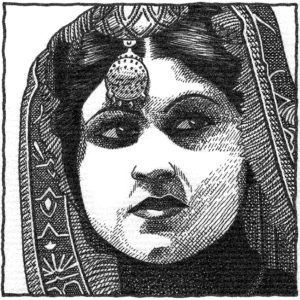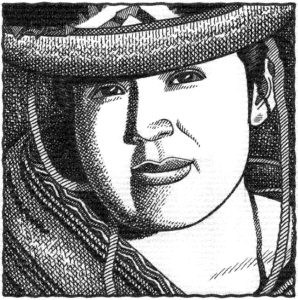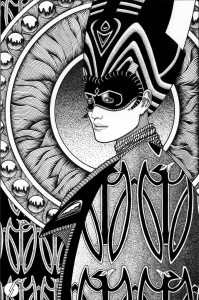BREAKING BARRIERS
Interview by Jocelyn Condé
©2017 KXVS
FROM CALIFORNIA TO GERMANY
Interview by Manuela Kohl
In the summer of 2010, I was contacted via Flickr by photographer Manuela Kohl of Emkeyfoto, Germany. Manuela wanted permission to use an image of an African woman that I had done years ago in an advertisement which would promote an exhibition that was taking place in her hometown in Germany. Manuela explained that the exhibition focused on the lives of three young women from three different places: Africa, the Andes and India. I told Manuela that not only would I like to redo the drawing of the African girl but that I would also like to add drawings for the other two cultures as well. Manuela surprised me by proposing to do an interview with me! The interview (in German) is available for viewing on her website, Emkeyfoto. We have chosen to not make any corrections and retain Manuela’s English from the original questionnaire that was sent to the artist. Even though Manuela’s English is excellent we wanted to retain the flavor and feeling of Manuela’s original questions.
Because of space and time restrictions Manuela has presented an edited version of our interview so I am posting the full interview (in English) for my regular readers. Manuela is very professional in what she does and I am excited to share the interview that she did with me with you, my dear readers. Danke Manuela!
Manuela Kohl Tell us who you are. Where you are coming from? What is your profession?
Salvador Castío Oh my God, Manuela, you’re already asking tough questions! I’m an artist; I say “artist” as opposed to, let’s say, “Illustrator,” because I like to work in different mediums and in different styles and so saying “artist” is what works best for me. If you get too specific in describing yourself then people label you or try to put you in a box and I don’t like being labeled. It’s the worst thing you can do to an artist. Perhaps I’m fighting an uphill battle by doing this but I have to stand my ground. Otherwise, people just roll over you. Basically, you can trace what I do back to two fields: illustration and comic book art, which is also a form of illustration. That’s where I come from but not necessarily what I do. Over time, your interests change and you form different ideas. What I want to do now is very different than what I wanted to do fifteen years ago.
Manuela Tell us about your special art. Your kind of drawing comics is developed by yourself. Where did it come from and what was your inspiration?
Salvador When I was in art school I majored in illustration and even though, stylistically, you can see that in my work it’s not really what I do. The main reason that I turn away from such things is because I hate art direction. I’m an intuitive person and that’s the only way I can work. Things have to be visceral and cerebral and above all personal. My “comics” style is something that I developed on my own when I was in high school. I would lock myself in my bedroom on weekends and practice up to 10 hours a day, especially inking with a brush. I started drawing at the age of five when my grandfather handed me one of my own comic books and said, “Dibuja esto,” which means “draw this” in Spanish. It was then that I knew that I wanted to be an artist. Until I was fourteen comic books were my main influence, but after that I absorbed many other things that also influenced me.
Manuela How important is the language of “pictures” and “art” in your life? What do you think is bringing art to the people?
Salvador Art is very important to me. If it wasn’t for art I would be miserable. When I was in grade school I suffered. I wasn’t the best of students and I had a very hard time with things such as mathematics. So, of course, the people at the school thought that there was something “wrong” with me and began pounding that idea into my head. It was incredibly frustrating for me. My mother suffered as well because of this stupid way of looking at things. Finally, in seventh grade, I had my first ever class devoted solely to art and that’s when I flew; that’s when my talent was finally noticed. I felt as if a huge weight had been lifted off my shoulders! It was really an incredible moment for me. Through comic books I discovered so many different things as a child and as a teen: cultural, historical, social, things from around the world. Despite the fact that I grew up in a “poor” neighborhood I was still able to expand my world view through reading comic books. So, things like comic books, animation, illustrated books, video games, movies, etc are some of the things that can impact you as a child. This is how one becomes exposed to art.
Manuela What is your motivation to start a drawing? Is it something you see or something you read? What’s your daily inspiration? 
Salvador My main motivation for drawing is always the same: to express something. As an artist, I can be inspired by many things: a book, a movie, a song, another artist’s work, or often just a feeling that comes to me out of the blue. My daily motivation is the need to grow and mature as an artist. I always want to draw better, that’s constant. These are the things that inspire me from day to day.
Manuela Which artists of the past and present do you prefer?
Salvador When I was a child I loved comic books and during that time, the early 70s, there were certain artists whose work was unavoidable: Jack Kirby, John Romita, Gil Kane, Neal Adams. It was their work that initially inspired me to want to start drawing. In my early teens things started to change and I started to become aware of other artists, painters from the past or artists that had either worked in comics and left comic books or that were illustrators that worked in illustration and not in comics. From that point on my tastes changed and grew and I started to learn about people like Burne-Jones and the Pre-Raphaelites, Alphonse Mucha, Salvador Dali, Picasso, etc. Even my tastes in comics began to change; I went from liking super hero comics to discovering the work of foreign comics artists such as Moebius, Philippe Druillet, Milo Manara, Enki Bilal, Caza and Jeronaton. There were other artists as well: Barry Windsor-Smith, Alberto Vargas, Wallace Wood, Dave Stevens, the list goes on and on. They were all important to me in one way or another. It was a time of change for me in many ways. It wasn’t long after this that I graduated from high school and went to art school.
Manuela What are you doing if you are not in business with your sketchbook? What you are interesting in? 
Salvador I’ve asked myself this question many times before and the answer is always the same, only art. I’ve done other things: dishwasher, library aide, care giver, security guard, and Spanish interpreter. Sometimes you have to do other things in order to survive and accomplish your goals. It’s not a pleasurable thing; you do it because you must. The last job I had was as a Spanish mental health interpreter where I was in a cubicle day after day. Often I would ask myself, “What the hell are you doing here?” I got along well with my coworkers, but I felt miserable on the inside. I remember, when I decided to quit, one coworker said, “You’re quitting while most of us are trying to keep our jobs.” She didn’t get it; lots of people didn’t get it. I was really tired of pretending to be something that I was not. It was during this time that I came to the conclusion that life is too short and that I had better do what made me happy before it was too late. Now I draw everyday and I feel totally different; I’m doing what I’m supposed to be doing.
Manuela How important is to reading a book or to listen to music? What kind of books and music do you prefer?
Salvador Reading books and listening to music are two very important things for me. I read a lot of biographies, especially about musicians and visual artists. They serve as a guide for me; they help me to understand where I’m going. They also serve as inspiration. I remember reading a lot when I worked as a security guard. Thankfully, the job was ultra boring and I had lots of time to read. I remember reading biographies of Picasso and Miles Davis, two people whom I admire greatly. Broken Music by Sting was also very inspirational to me at that time. I could totally relate to what they went through; I knew what they were talking about because I was going through the same types of things. Music has always been very important to me. I started buying records, 45s, when I was six years old. I grew up listening mostly to rock and roll. When I was in high school my tastes began to change, I became interested in music that was obscure or hard to find. I bought lots of import albums. One person that I discovered at this time was Kate Bush. I remember buying her CD, The Whole Story, and it blew me away. I had never heard anything like it before. At the time I wasn’t sure if I was going to keep it or return it, but something inside me told me to keep it and give it a chance. Eventually, I became addicted to it. As I’ve gotten older I’ve started to explore other forms of music, especially flamenco, jazz and blues. The music of people like Camarón de La Isla, Miles Davis and Robert Johnson has greatly expanded my ideas on music.
Manuela Are you working in graphics and illustrations? Would you illustrate headers for websites for example?
Salvador No, I don’t work in those areas. As I said before, I majored in illustration when I was in art school but it’s not what I do now. The work I do know is self directed. I don’t work well with art direction; I tried doing that for years and all I got from it was frustration and work that I hated. People would commission me and then they would start art directing everything to the point that I felt that I would no longer be present in the finished piece. This is why I almost never accept commissions anymore. With the advent of the Internet I can produce exactly what I want and sell it to whoever wants to buy it. When I graduated from art school in the early 90s things were different; at that time if an artist wanted exposure he was at the mercy of galleries and publishers. Now, thankfully that has changed; there are more options available. 
Manuela Where can we see more of your work? Do you have a portfolio? Do you sell your work?
Salvador Yes, you can see my work on my website gallery at www.salvadorcastio.com
Manuela Is there something special or an important project that you want to tell the readers about?
Salvador I’m working on a website. That’s important because it will be a way to connect directly with people that are interested in my work and interested in knowing more about me. On my site people will be able to purchase originals and limited edition prints. I’m also going to maintain a drawing blog that is separate from my main website. I have chosen to do this because I always carry my sketchbook with me and I need an outlet for that. I’ve kept a sketchbook since I was in high school so it’s something that is important to me. For now I am going to be concentrating on new drawings and paintings that I want to turn into limited edition prints. Some will be portraits of influential people such as Picasso, Frida Kahlo and Miles Davis. I want to do a series of drawings of flamenco singers as well. I want to do some paintings that will be less structured and more intuitive, spontaneous and without any rules. I also want to explore eroticism and social commentary in my work. Finally, I would like to take this opportunity to invite your clients to view my work at www.salvadorcastio.com and ask them to share their thoughts by leaving comments in the blog section of my site. If they have any questions they can email me at: artist@salvadorcastio.com. I would also like to thank you, Manuela, for giving me the opportunity to share my work with you and your clients.
Interview ©2011 Manuela Kohl
REALITY and FANTASY COMBINE IN THE ARTISTIC EXPRESSION OF SALVADOR CASTÍO
Interview by Manuel Tobias
In 1996 I participated in La Mujer, an exhibition that celebrated the Hispanic woman. I contributed two portraits of Mexican painter Frida Khalo to the show and because of this I was approached by Manuel Tobias, the publisher of the now defunct Spanish language newspaper El Latinoamericano about being interviewed for an article about me and my work; here is that interview. The original interview in Spanish will be made available as soon as a copy can be located.
Traveling through the infinite worlds of artistic imagination we could never come to know just how many creations could be possible. The more we analyze this, the bigger the creative source seems to be.
The world of art, through a diversity of styles and expressions, has shown us innumerable and famous painters who, on the majority of occasions have reflected ideas about nature. However, the painters that have and will always draw the most attention are those that have as their intent the human form and human nature, especially where there is an emphasis upon the female.
One of the up and coming talents in this broad, interesting, and profound field is Salvador Castío. Salvador was born and raised in the Bay Area and he is a graduate of San Francisco’s Academy of Art College where he majored in illustration. He emphasizes that his work is mainly a mixture of reality with modern day imagery of the fantastique that relates to the future.
Salvador has already had works published as limited edition prints and magazine covers, one of those images accompanies the current article and was distributed in Canada and England. 
How did this restlessness for art come about in Salvador? he responds on the matter, “I consider that my interest for painting began at the age of five during a significant moment when my grandfather picked up a comic book and said, ‘Here, draw this.’ ” From that moment my passion for drawing started.”
“As I was growing up, until the age of fourteen, my main motivation had been comic books but my interest in art began to grow and I became deeply interested in the genre of fantasy. As an admirer, I began to develop my interest in poster art and also to take this kind of work more seriously,” said Salvador.
After his graduation Salvador started his own comics publication that was published during an opportune moment but questions of competition and the ambition to develop more projects have led him to create his own fantasy characters that have been published as posters.
Salvador is part of Northern California’ new generation of painters and while he continues to explore the never-ending fantasy genre, he also takes time to paint in watercolor – his specialty – and India ink, two mediums that have allowed him to exhibit alongside experienced graphic artists of the region.
“In 1993,” said Salvador, “My work was seen by a New York publisher and I had the luck of having a limited edition poster of one of my drawings marketed,” added Salvador.
Why don’t you use your talent for commercial purposes?
“The career I have chosen allows me to work in any genre for any publisher, it’s the same for me to draw a car, a house or a landscape but it’s not what I like to do,” assured Salvador.
“The ideas generated by the imaginary and the fantastic are what fill me with passion, ideas out of the ordinary are what most attract my attention. Also, I search with great effort for something that will define my own identity because of my originality and that I can use as my signature. It doesn’t matter if others criticize my work as crazy. Perhaps this is why one of my favorite painters is the celebrated Salvador Dalí who always surprised the world with each work which for many were authentic works of madness but were surprising for others,” concludes Salvador.
Amongst the artists that Salvador admires are French comics artist Philippe Druillet, film-maker Alejandro Jodorowsky and the writer Carlos Castaneda.
©1996 Manuel Tobias

